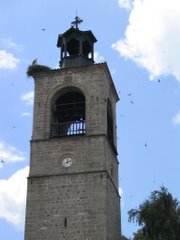It would be understandable if Bulgaria--ancient Roman annex, Ottoman Empire conquest, Soviet Union satellite--wasn't all that welcoming to foreigners. But there I was in Sofia, on my way to the public drinking fountains where locals fill up old Coke bottles with hot mineral water, when a lady pointed out that the bottle of wine I was carrying had broken through its plastic bag. I tucked the bottle back in as best I could and said thank you--good deed done, as far as I was concerned--but the woman kept cheerily talking in Bulgarian as she emptied one of her own shopping bags and insisted I take it to replace my ripped one.
Hospitality in hand, Bulgaria is the next little thing on the international travel scene. The Balkan nation joined the European Union on Jan. 1, with blue flags waving in the streets on New Year's Eve, yet only in recent years have tourists ventured much beyond Black Sea beach towns and into the Ohio-size expanse of rose farms, medieval monasteries and Roman ruins. Visitors, especially Western Europeans, are flocking to ski resorts in the Rila and Pirin mountains and have even sparked a property boom in Bansko, where investors are scooping up cheap vacation homes. Meanwhile, low-cost labor, economic incentives and proximity to the rest of Europe are luring record levels of foreign investment from companies like French car-parts manufacturer Montupet, Chinese TV maker SVA and U.S. energy firm AES--even though Bulgaria still has a ways to go in cleaning up corruption.
Then there is Sofia, which has the air of being on the cusp of discovery. (Impress your hipper friends by talking about how you visited after tiring of Prague.) The taxi driver from the airport was surprised to learn that I was American, as were vendors in the fruit market, although everyone under 30, it seemed, spoke English. Road signs in the capital are in Cyrillic, and Old World and communist-era charms abound--men in chapeaux, women with bright red dye jobs--but there are also plenty of skinny young things running around in tight jeans and tall boots, heading to hot nightclubs like Chervilo and Briliantin that don't get going before midnight.
The tourism industry here isn't exactly supersophisticated--the Sheraton's approach to wake-up calls, for example, is laissez-faire--but more amenities are popping up, including high-end hotels like Arena di Serdica, built around the ruins of a Roman amphitheater, and Grand Hotel Sofia, which overlooks the Sofia City Garden, the former Royal Palace (now an ethnographical museum) and the National Theater. The nicest rooms top $300 a night, after converting from the euros that most hotel rates are listed in, alongside the price in Bulgarian leva.
Sofia easily matches the rest of Europe in cobblestone streets and cathedrals. Aleksander Nevski Memorial Church, a massive neo-Byzantine tribute to the Russian soldiers who died fighting for Bulgaria's independence from the Turks in the late 19th century, is well trafficked, as are the souvenir stalls outside selling communist and Nazi paraphernalia. Fewer sightseers meander into the Sveta Nedelya Church, where Sofians gather for incense-imbued Bulgarian Orthodox services in a mural-covered sanctuary. It was there that a church employee approached my camera-toting travel companion, asking to be photographed. We wound up sharing warm bread in a side office, even though we didn't share a language.
The center of Sofia brims with Old Country attractions--the changing of the presidential guard, streets made from yellow bricks gifted by Austrian Emperor Franz Joseph I--but the city of 1.2 million is compact enough for visitors to venture to locales off the beaten track, like the communist monument turned skate park in Borisova Gradina and the Ladies' Market, where average-income Sofians do their shopping. The marketplace of storefronts and open-air kiosks sells everything from clementines to wallpaper to negligees to banitsa, a flaky pastry stuffed with the feta-like "white cheese" used in many Bulgarian dishes. One kiosk sells mulled wine from barrels for 1.2 leva, about 80¢, a liter--a price indicative of how very far the dollar goes. The top end is a bargain too. At Pri Yafata, an upscale restaurant serving traditional Bulgarian cuisine (which means Turkish and Greek influences plus a proclivity for using all parts of the animal--hot pig's head soup, anyone?), a folk-style three-course dinner for two with wine can be had for $35.
That, though, is starting to change. Bulgaria doesn't move to the euro until 2010, but the country is already seeing the effects of integration with the European economy. The Sofia Echo, an English-language weekly, reports that in the last few months of 2006, the price of bread went up more than 10% and is expected to increase another 20% to 50% this year. The evolving landscape is perhaps nowhere better observed than at the gleaming new glass-wrapped Mall of Sofia, where locals sip $2.60 caramel macchiatos, browse stores such as Lacoste and Hugo Boss and take in movies at Bulgaria's first IMAX theater.
Across town, you can still fill up a used soda bottle with hot mineral water next to the old Turkish baths, but to the extent that you believe progress and popularization displace authenticity, you should head over sooner rather than later.
By Barbara Kiviat

No comments:
Post a Comment